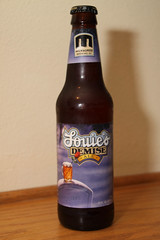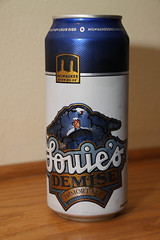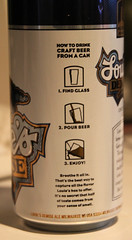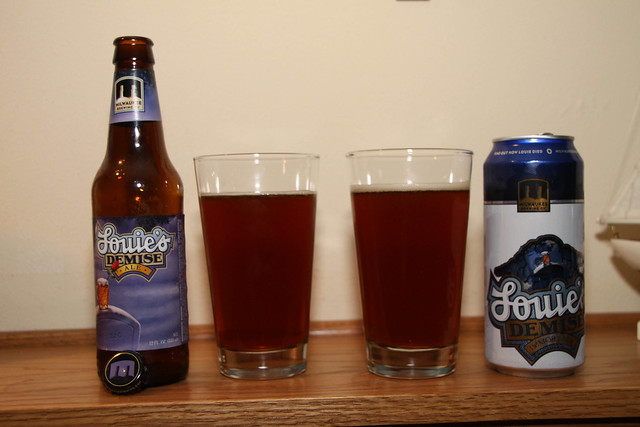I love beer from cans. There are so many advantages to the canned beer that I find it hard to believe that more breweries aren’t installing canning lines. There is still a common perception that craft beer must come in bottles. Because of this I wanted to investigate the differences myself.
There are several advantages to beer in cans:
- Light Protection: Beer does not like light. Dark brown bottles do a decent job of keeping light out, but aluminium cans do a better job. One just needs to look at a glass bottle and a can to know why.
- Oxygen Protection: Cans get a tighter seal and keep oxygen out of the beer than a bottle cap can.
- Cans are cheaper for the brewery to produce. Bottles usually have two labels applied to them One on the neck and one on the main bottle. Cans are painted at the factory and come pre labeled, saving the brewery the costs of attaching the labels. In addition
- Cans don’t break as easily. It is possible to damage a can to the point that a hole can form in the packaging, but it takes a lot more force than a glass bottle to break.
- Cans are stackable. It’s tough to stack a longneck bottle, but cans are designed to be stacked.
- Cans take up less space. Comparing a 12 oz bottle with a 16 oz pint can it’s easy to see that the can takes up a much smaller space while still managing to hold more beer.
- More fit in the fridge. Since they take up less space, and are easily stackable, they fit in your fridge at home better. This is good news, not only for you, but also for liquor stores who can fit more product into their coolers. Distributors can fit more cans in their trucks which should also keep prices lower.
- Cans are more portable. Because of their higher tolerance for abuse, their smaller space, and restrictions on glass at certain venues, cans are a better option to take with you when you’re drinking out and about.
- Cans cool down quicker. Aluminum is a better conductor of heat than glass, therefore a caned beverage will chill quicker than a bottled one.
- Cans are more environmentally friendly. Aluminium is easier to recycle than glass, and the small plastic pieces used to hold the cans together is much smaller than the box used to keep a six back of bottles together.
Why Bottles?
If there are so many advantages to cans, why do most craft breweries still bottle their beer? The answer here is easy. Most small breweries don’t have a huge amount of cash available to them when they start out, and they buy used packaging equipment. There are more used bottling lines on the market than there are canning lines, so the equipment for bottling is much cheaper.
As cans take hold of the market in a bigger way, I expect to see more breweries follow in the footsteps of Oskar Blues, Surly and other breweries that only sell their beer in cans.
Testing, Testing, 1.2.3.
In an effort to determine the differences between canned and bottled beers for myself, I purchased some cans and bottles of Louie’s Demise from Milwaukee Brewing Company. They offer a few different beers in both cans and bottles, which makes for a good test bed so I can compare apples to apples.
I started out looking at the packages themselves. First the bottle:
As you can see, the bottle has a very attractive drawing on the label. Other details on the packaging are sparse. The neck label includes the brewery’s name, a barcode, and the states where there is a deposit available for recycling. The main label lists the size of the bottle, the name of the beer, the URL for Milwaukee Brewing’s website, and the Government Warning about not drinking while pregnant, or driving a car. There isn’t room for a description of the beer, or any other information on the bottle’s labels.
The can has drastically different packaging however.
The beer’s name is far more prevalent on the front of the can. In fact, on the back of the can, the beer’s logo is reproduced and this reproduction is only slightly smaller than the logo was on the bottle. It appears that there are some color limitations with the painting process because the background around the name, and the clouds in the drawings are very pixelated in order to reproduce the color variations present in the original drawing. Unfortunately the gravestone drawing was reduced in size and due to the paint limitations, I found it very difficult to even make out what it was supposed to be a picture of. If I didn’t have a bottle here for comparison, I wouldn’t have been able to point out that it’s a gravestone with a glass of beer and a rose on it.
However, as you turn the can around and look at the back, this is where the packaging shines. Because of the increased area for printing, they were able to reprint the logo, a description of the beer, and a suggestion to pour the beer into a glass before drinking.
Apart from the color limitations on the front of the can, I find the cans packaging to be much more attractive than the bottle. I only wish they were able to better reproduce the gravestone drawing from the bottle because I really like that imagery.
Pouring

Because I wanted to keep this a blind taste test, I asked my wife to pour the two beers into identical glasses. After she poured I came over to investigate, and I found the appearance to be very similar. The glass she had poured second had a slightly larger head, but it quickly receded and both glasses became nearly indistinguishable. The beer in glass number 2 (which was later revealed to be from the bottle) was slightly darker in color, but this may have been a trick of the lighting since I can’t see evidence of it in the pictures.
The taste
There is a common belief that beer from a can tastes more metallic than the beer from a bottle. Modern packaging techniques include applying a coating to the inside of a can to remove any possibility of the metallic flavors intruding the beer, but does it work? Let’s face it, if there is a significant flavor difference between the two packaging options, then the argument is settled.
The results of the taste test actually surprised me a little. At first I couldn’t taste any differences between the two glasses. I let the beer warm a little and sampled again, and I still couldn’t taste any differences. When I was almost finished with both beers, I made a guess. I guessed that the contents of glass number two was the can. I thought I detected a slight metallic flavor that although it was hidden in the background, seemed to be just noticeable. I told Angie my guess and she was glad to tell me that I was wrong.
Since I’ve checked the bottle and there was no signs of a chunk of metal inside, I can only say that I’m pretty sure the metallic flavor was due to my own psychological expectations of tasting something slightly off in one of the two beers. In the end however, I’m confident to say that the flavor was not adversely effected by the canning process.
In this experiment I was able to prove my suspicions that there is no difference between the flavor of a canned beer. I will continue advocating for craft beer in cans, and I’ll continue drinking beer from a can (in a glass of course). Next time you’re in the liquor store and you’re deciding what to drink, I encourage you to take your next beer in the can.
*** EDIT***
Shortly after posting this article originally, I was told that I missed a crucial point. During the packaging process the beer is exposed to Oxygen. This is bad for beer, and should be minimized. Bottling lines have either a snifter or a knocker to help reduce the amount of oxygen in the bottle before it is sealed. A snifter injects the bottle with water, and a knocker, well it knocks the bottle. As the beer is bottled, these tools help cause a foaming of the beer (fobbing) and that drives out excess oxygen from the bottle.
A canning line can’t do either of those steps to cause the beer to foam, so the brewer must use undercover gassing to prevent air exposure. This is the process of injecting a blanket of CO2 into the can before the package is sealed at the seam. Many cheaper canning lines don’t include this undercover gassing equipment, and therefore beer canned in one of these lines is exposed to more oxygen during the canning process.
Minimizing oxygen exposure is crucial to the quality of the beer, and an additional argument in favor of the bottling process.




